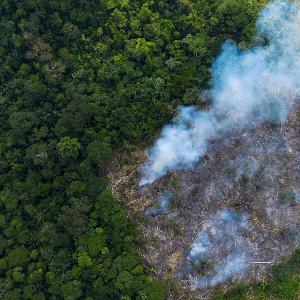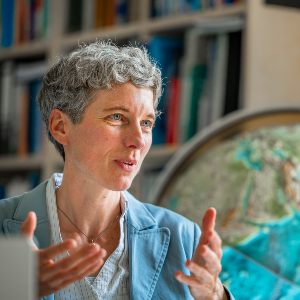5 critical climate tipping points: What now?
Climate change is transforming our planet – irreversibly in some cases. How much time do we have left to act before the climate tips? And what new realities will we have to confront?

Climate change is transforming our planet – irreversibly in some cases. How much time do we have left to act before the climate tips? And what new realities will we have to confront?

The consequences of global warming – currently around 1.5°C above preindustrial levels – are already decidedly tangible. Meanwhile, some parts of the Earth system are beginning to radically change. Over a hundred researchers from all over the world and from numerous scientific disciplines have come to the conclusion that some of these tipping points have either already been reached or will be very shortly.
From a scientific perspective, moreover, it is certain: To avoid such major upheavals, we need a complete reduction of emissions and the removal of carbon dioxide from the atmosphere. We present five critical climate tipping points from the current Global Tipping Points Report 2025. LMU researchers explain how we can deal with an increasingly unstable climate system.
A combination of direct destruction and climate-change-related intensive drought is plaguing the tropical rainforest in the Amazon basin. The warming of the surface water in the tropical Pacific and Atlantic is playing an important role here. According to scientific estimates, the tipping point for the widespread die-off of the Amazon rainforest is around 3.5°C of global warming (between 2 and 6°C). However, these estimates do not factor in the effects of deforestation. When we include these, the threshold is probably much lower.
At stake here is not just a biodiversity hotspot, but also an ecosystem which itself has a considerable influence on the global climate. For this reason, too, it is vital to protect the existing rainforest from deforestation and to reforest lost areas. This is a global task, as besides the world’s greed for high-quality tropical timber, areas are also being cleared to grow other products that are shipped all over the world.

© LMU
Julia Pongratz is Professor of Physical Geography and Land Use Systems at LMU, member of the Council of Experts on Climate Change, and member of the Scientific Advisory Board for Nature-Based Climate Action.
The tipping point for the thawing of permafrost on land has been estimated at 1.5°C global warming and has presumably already been reached. The permafrost in Northern Eurasia and North America is particularly affected. As thawing permafrost releases greenhouse gases, it further exacerbates climate change. The tipping point for the complete melting of mountain glaciers is thought to be 2°C global warming, although individual factors such as the local microclimate also affect the melting of a glacier.
Because glaciers shape the local water balance and, in conjunction with permafrost, ensure the stability of whole mountains, many people will have to adapt to radical changes and greater natural hazards. Especially in densely populated regions like the Alps, protective structures and early warning systems are already becoming necessary.

© privat
Ralf Ludwig is Professor of Applied Physical Geography and Chief Sustainability Officer at LMU.
Increasingly, excessive water temperatures are causing coral bleaching, whereby the polyps expel their symbiotic algae, which are important for their long-term survival. The frequency and duration of these heatwaves are making it hard for the builders of tropical coral reefs to regenerate, and so it seems that these species-rich ecosystems will inexorably disappear. Researchers hypothesize that the tipping point lies at 1.2°C global warming – and has thus already been well exceeded.
Nevertheless, we could still do something about it and at least gain some time: In addition to fighting against the further warming of the oceans by means of resolute climate action, we should reduce other anthropogenic stressors – particularly water pollution and overfishing. After all, building artificial reefs as coastal protection, a habitat for fish, and a diving amenity will never be able to fully replace this precious ecosystem.
2:16 | 13 Nov 2025
At least some regions that are still covered with ‘permanent’ ice will soon be facing major upheavals: The tipping point for the melting of some polar ice sheets is estimated at around 1.5°C global warming – and has therefore already been reached. The Greenland and West Antarctic ice sheets are particularly close to collapse. This threatens in the long term to cause a further significant rise in sea level, which is already posing problems in many coastal regions today.
The authorities in the Netherlands are already raising the height of dikes so that they can cope with a few extra meters. Although people have long been wresting land from the sea through such structures and subsequent permanent drainage, this too has technical and financial limits. Many islands and cities are therefore faced with the long-term prospect of becoming wholly or partially uninhabitable.

Matthias Garschagen is Professor of Human Geography and Human-Environment Relations at LMU and lead author for the IPCC.
Climate change is altering the global network of ocean currents. The Subpolar Gyre (SPG) in the North Atlantic is already measurably weakening, while research findings indicate that the Atlantic Meridional Overturning Circulation (AMOC) is undergoing similar change. As an extension of the Gulf Stream, the AMOC not only brings heat to Europe, but generally has a major influence on global weather activity and affects numerous other climate tipping points.
Researchers reckon that its tipping point is at 2°C global warming, but cannot exclude based on current data that it will be reached sooner – or perhaps has already been crossed. To make the complex models and forecasts more precise, we urgently need more measurement data – from the ocean depths, for instance, and long-term measurements. In view of the global significance of ocean currents like the AMOC, this research is hugely important.

© Haumann
Alexander Haumann is professor of physical geography with a focus on oceanography at LMU and the Alfred Wegener Institute.
LMU climate research:
Climate protection: “The forest is our greatest ally”
“We have to adapt to new realities”
Coastal cities and adaptation to climate change
Polar research: Warming in the cooler
Read more articles from LMU's research magazine in the online section and never miss an issue by activating the magazine alert!